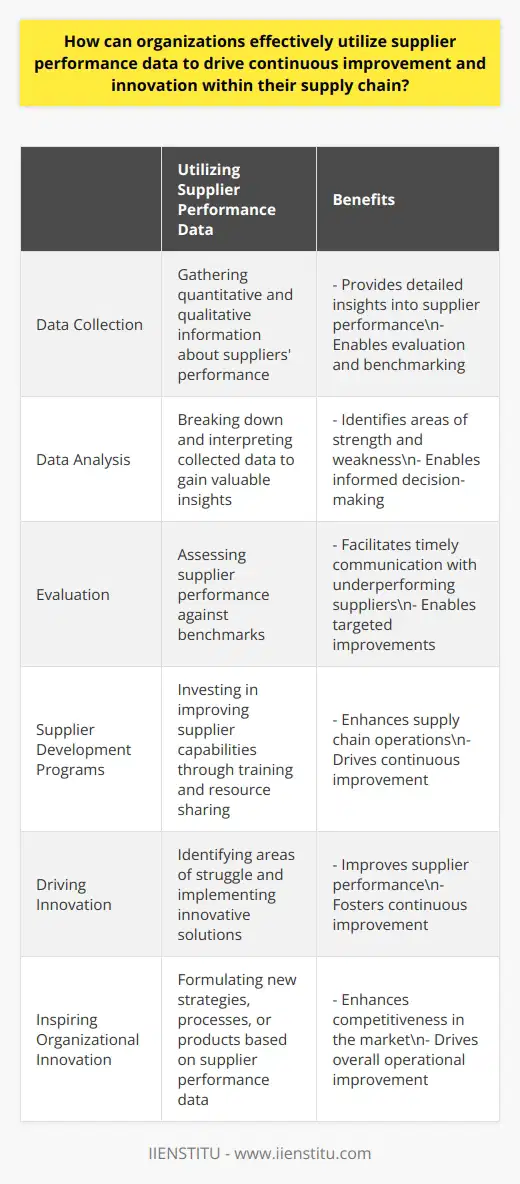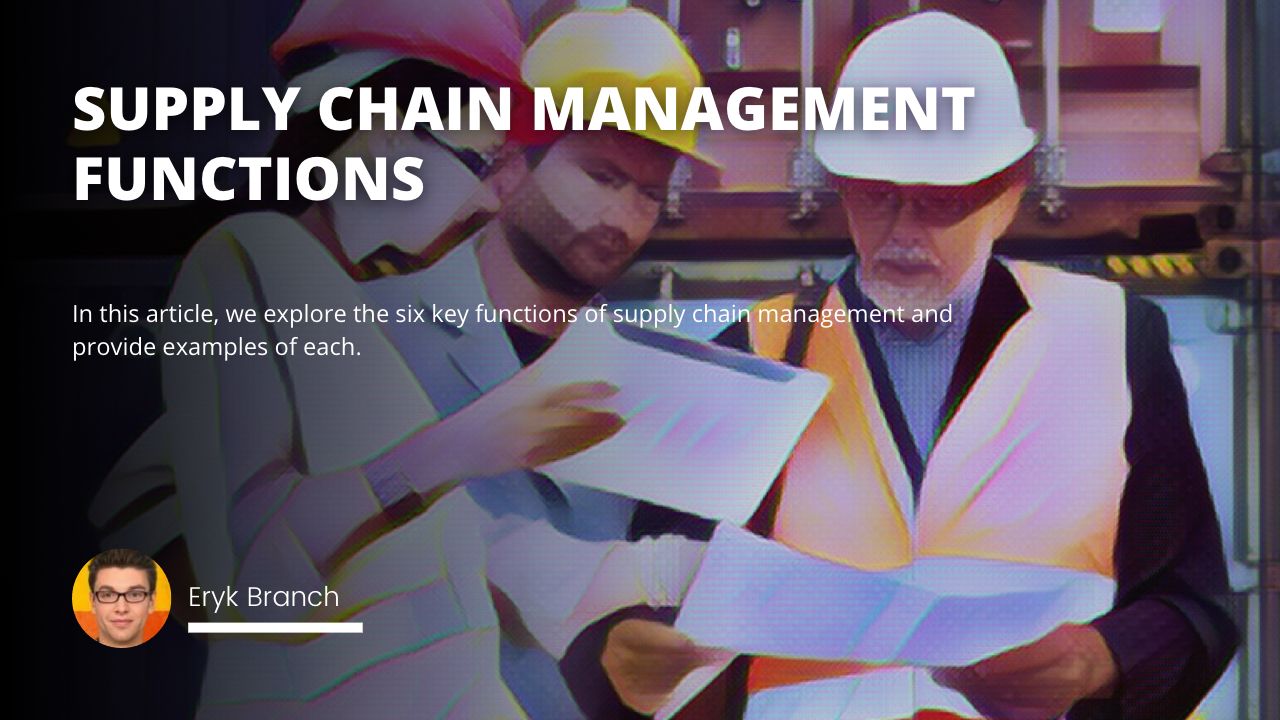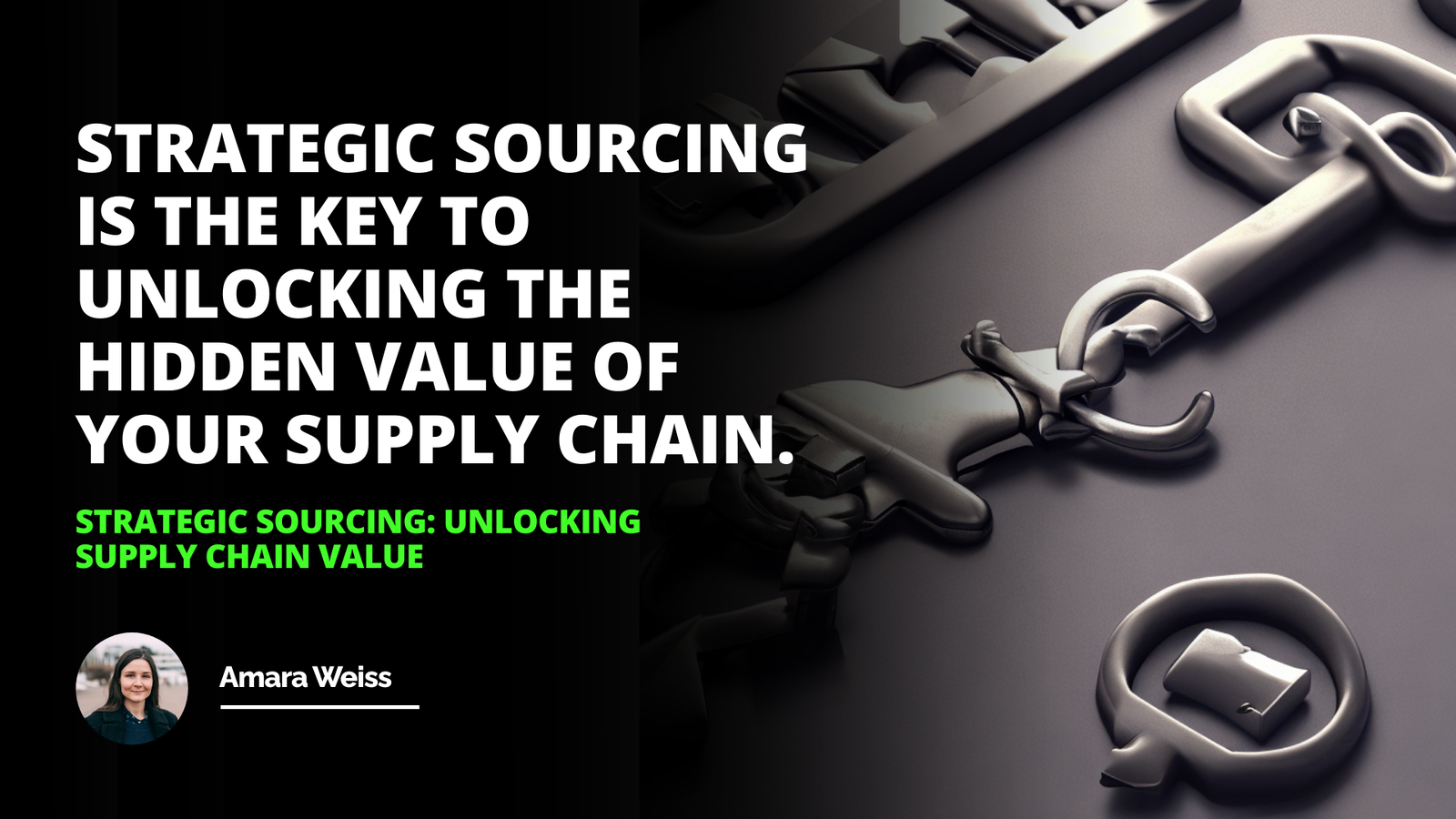
Benefits of Supplier Performance Management
Challenges to Implementing Supplier Performance Management
Best Practices for Effective Supplier Performance Management
The Future of Supplier Performance Management in Supply Chain Management
Supplier performance management (SPM) is a process of managing the performance of suppliers to ensure that all suppliers meet their contractual obligations and deliver quality products, services, and support on time and at the right price. SPM is a strategic process used to monitor, measure, and analyze supplier performance and adjust the procurement process and supplier contracts as needed.
Benefits of Supplier Performance Management
Effective supplier performance management can offer significant benefits to businesses. It can help reduce costs by identifying areas where quality, timeline, and pricing can be improved. It can also help improve the overall supply chain performance, increasing customer satisfaction and operational efficiency.
SPM also offers better visibility into supplier activities and performance, allowing businesses to identify potential issues before they become significant problems. This improved visibility can help organizations make more informed purchasing decisions and reduce the risk of non-compliance with regulations.
Challenges to Implementing Supplier Performance Management
Implementing SPM can be a complex and time-consuming process that requires careful planning. Therefore, it is essential to ensure that the SPM system is appropriately designed and implemented to ensure that it is effective and meets the organization's needs.
Additionally, the implementation of SPM can be expensive and require significant resources. Therefore, organizations must consider the cost of the system and the resources needed to maintain it. It is also essential to ensure that the system is regularly updated to reflect market changes and provide that it is still relevant.
Best Practices for Effective Supplier Performance Management
There are several best practices that organizations can use to ensure that their SPM system is effective and meets the organization's needs.
The first best practice is to define the performance metrics that will be used to measure supplier performance. These metrics should be based on the goals and objectives of the organization. In addition, it should be tailored to the organization's specific needs. Ensuring these metrics are regularly monitored and updated is also essential.
The second best practice is establishing a system for tracking supplier performance and analyzing the data. This system should include manual and automated processes to ensure accurate and up-to-date data. It is also essential to ensure the system is user-friendly and easy to understand.
The third best practice is to establish a feedback system for suppliers. This feedback system should allow suppliers to provide feedback on their performance, enabling organizations to make informed decisions about supplier performance and identify areas that need improvement.
The fourth best practice is to develop a system for addressing supplier issues and resolving disputes. This system should include a process for managing and resolving disputes quickly and efficiently. It should also have a strategy for monitoring and tracking supplier performance over time to ensure suppliers meet their contractual obligations.
The Future of Supplier Performance Management in Supply Chain Management
Supplier performance management is integral to supply chain management, and its importance will likely increase. As organizations become increasingly reliant on their suppliers, it will be essential to ensure that they are meeting their contractual obligations and delivering quality products, services, and support on time and at the right price.
Organizations must implement effective SPM systems to ensure they get the most out of their suppliers. This will require sophisticated data analysis and automation tools to ensure that the data is accurate and up-to-date. Organizations will also need to establish feedback systems to ensure suppliers meet their performance goals and identify improvement areas.
The future of SPM is likely to involve more collaboration between organizations and their suppliers. This will help ensure that both parties work together to achieve the best possible results. Additionally, organizations must ensure that their SPM systems are regularly updated to ensure they are still relevant and meet the organization's needs.
Conclusion: Supplier performance management is essential to effective supply chain management. By implementing effective SPM systems, organizations can ensure that their suppliers meet their contractual obligations and deliver quality products, services, and support on time and at the right price. Additionally, organizations can use SPM to identify areas where quality, timeline, and pricing can be improved. The future of SPM is likely to involve more collaboration between organizations and their suppliers, as well as the use of sophisticated data analysis and automation tools.
The key to successful supplier performance is understanding their capabilities and working together to reach mutually beneficial goals.
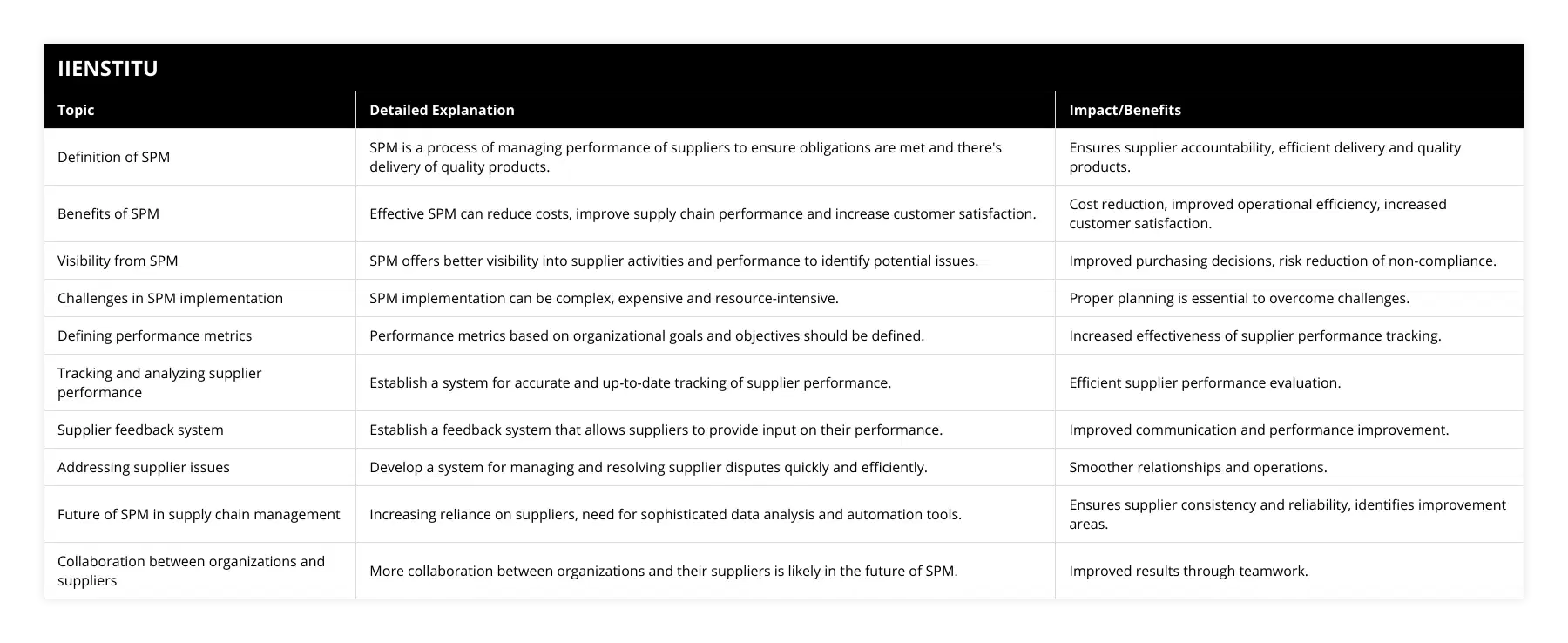
Effective supplier performance management (SPM) is crucial in assuring suppliers meet their obligations, improve quality, timeline, and prices, thus increasing the overall supply chain performance. Although the implementation of SPM is complicated and costly, with precise planning and design, its benefits make it worthwhile for businesses. Utilizing established best practices, such as defining performance metrics, tracking supplier performance, soliciting feedback, and developing a system for resolving disputes, can optimize the success of an SPM system. The future of SPM will be even more significant to supply chain management, requiring accurate data analysis, automation tools, and increased supplier collaboration. Thus, supply chain certificate programs are likely to give more emphasis to the SPM to equip professionals with necessary skills to implement, manage and enhance supplier performance systems effectively.
Frequently Asked Questions
What are the benefits of implementing Supplier Performance Management?
Supplier Performance Management (SPM) is a comprehensive system for managing supplier relationships and performance. It enables organizations to evaluate and monitor their suppliers to identify improvement areas and make informed decisions about future collaborations. This paper will discuss the various benefits of implementing SPM within an organization.
One of the most important benefits of implementing SPM is increased visibility into supplier performance. By tracking supplier performance metrics, organizations can quickly determine which suppliers are meeting their expectations and which are not. This helps organizations work with reliable and trustworthy suppliers who can provide the best quality products or services at a competitive price. Additionally, it gives organizations greater control over their supply chain by allowing them to make more informed decisions about which suppliers they should work with in the future.
In addition to increased visibility into supplier performance, another benefit of SPM is improved communication between stakeholders in the supply chain. With SPM, organizations can easily track issues or delays in deliveries or services and any discrepancies between what was promised and what was delivered by suppliers. This allows for better collaboration between stakeholders so that problems can be addressed quickly and efficiently before they become too costly or damaging to the relationship between an organization and its suppliers.
Finally, another benefit of SPM has improved cost savings for organizations due to better management of resources such as inventory, labor costs, material costs, etc., all of which contribute to overall financial protection for an organization over time if managed correctly through SPM systems. By monitoring resource usage more closely through advanced analytics capabilities provided by SPM systems, organizations can better understand how much they need to invest in materials or labor costs to produce a certain quantity of product at a certain quality level without sacrificing efficiency or safety standards set by regulatory bodies such as OSHA (Occupational Safety & Health Administration).
In conclusion, many advantages are associated with implementing Supplier Performance Management systems within an organization. It increases visibility into supplier performance metrics and improves communication between stakeholders within the supply chain while helping reduce operational costs associated with managing resources efficiently over time.
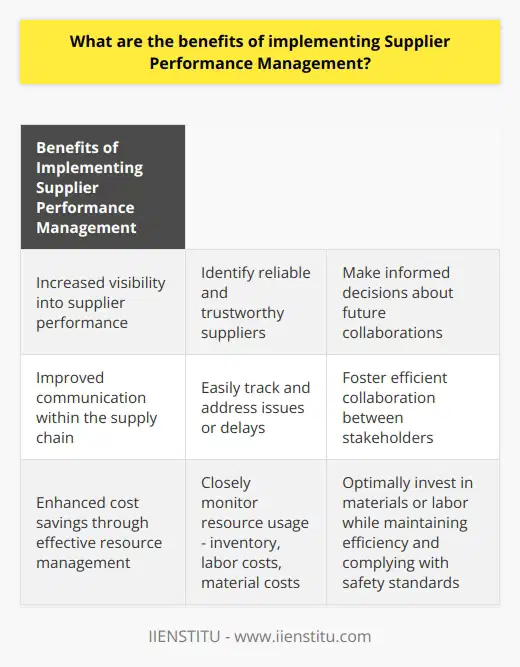
What challenges should be considered when implementing Supplier Performance Management?
When implementing Supplier Performance Management (SPM), it is essential to consider the challenges that may arise to ensure successful implementation. While SPM may have the potential to provide the organization with cost savings, improved product quality, and improved supplier relationships, it also requires a significant amount of time, effort, and resources to implement.
One of the primary challenges of implementing SPM is identifying the performance measures that will be used to evaluate suppliers. Therefore, it is essential to remember actions that accurately reflect the desired performance from suppliers, such as cost, quality, delivery, and responsiveness. Additionally, it is necessary to define the criteria for assessing performance, such as the weighting of each measure, the acceptable performance level, and any thresholds that must be achieved.
Another challenge is ensuring that the data used for performance evaluation is accurate and up-to-date. It is essential to ensure that data is collected and reported promptly and that any discrepancies are addressed. It is also necessary to ensure that the data is being used in the proper context to reflect supplier performance accurately.
In addition, ensuring suppliers are appropriately incentivized to meet performance expectations can be challenging. Therefore, organizations must have a clear and transparent system of rewards and punishments to motivate suppliers to perform at their best. This should include financial and non-financial rewards and punishments, such as recognition and improvement plans.
Finally, ensuring that SPM is regularly monitored and evaluated is vital. It is essential to ensure that performance measures and criteria remain relevant and that performance expectations are met. Identifying any improvement opportunities and taking corrective action when necessary is crucial.
In conclusion, several challenges must be considered when implementing Supplier Performance Management. It is essential to identify the performance measures, ensure accurate and up-to-date data is used for evaluation, motivate suppliers to meet performance expectations, and regularly monitor and evaluate the SPM process. By taking the time to consider these challenges and taking the necessary steps to address them, organizations can ensure the successful implementation of SPM.
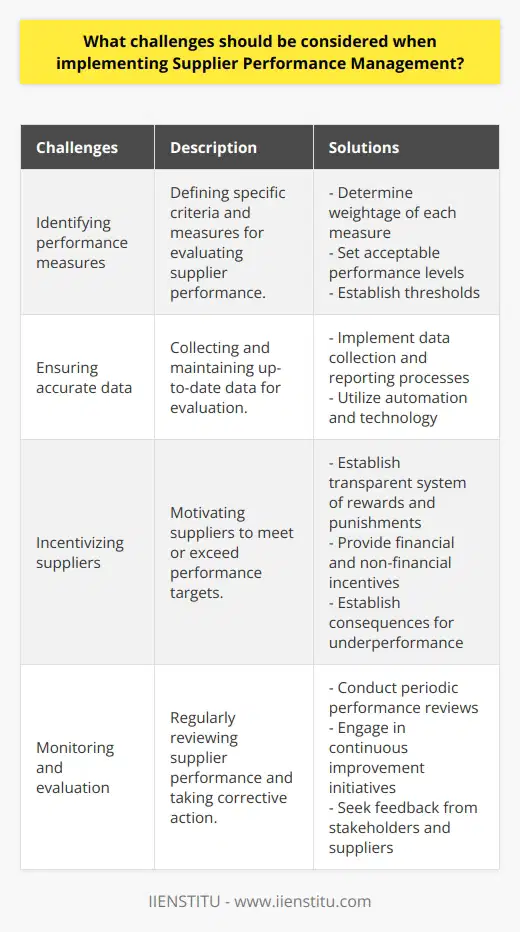
How can businesses ensure that their Supplier Performance Management system is effective and meets their needs?
Supplier performance management is a critical component of any business’s success. It is essential for companies to accurately assess the performance of their suppliers to ensure the quality of goods and services received, as well as the cost efficiency of their operations. An effective supplier performance management system should be tailored to the specific needs of each business. It should be regularly reviewed and adjusted as necessary. This article will discuss some best practices for companies seeking to ensure that their supplier performance management system meets their needs.
First, businesses must establish clear goals and objectives for supplier performance measurement. This includes setting expectations for both cost savings and quality assurance initiatives, as well as defining key indicators which can be used to measure progress toward these goals. This process should involve representatives from the supply chain team and other departments within the organization to ensure that all stakeholders know their roles in meeting these objectives.
Next, businesses should select appropriate tools for measuring supplier performance. This includes establishing a method or system that provides accurate visibility into supplier performance data while offering efficient reporting capabilities, such as automated dashboards or scorecards, which executives and other decision-makers can use. Additionally, businesses may consider utilizing analytics software to help identify patterns in supplier behavior that may indicate areas needing improvement or where more cost savings could be achieved.
Once suitable measurement tools have been identified, businesses must develop a process by which they will review suppliers’ performances on an ongoing basis. This may include regularly scheduled meetings with suppliers to discuss progress towards meeting goals and objectives established during initial setup phases. Additionally, businesses should develop feedback loops between those responsible for managing supplier relationships and other departments within the industry to ensure that any changes made are adequately communicated to all relevant parties involved in the supply chain process.
Finally, it is essential for companies engaging in supplier performance management initiatives to have processes in place for addressing any issues identified during these reviews. These processes should include clearly defined escalation paths so that any issues requiring further attention can quickly be identified and addressed accordingly with minimal disruption or delay caused by communication breakdowns between those involved in managing supplier relationships within an organization.
By following these best practices when establishing a Supplier Performance Management system, businesses can better ensure that they are getting maximum value out of their relationship with suppliers while also ensuring that they meet internal goals regarding cost savings initiatives or quality assurance standards by upper-level management teams within organizations.
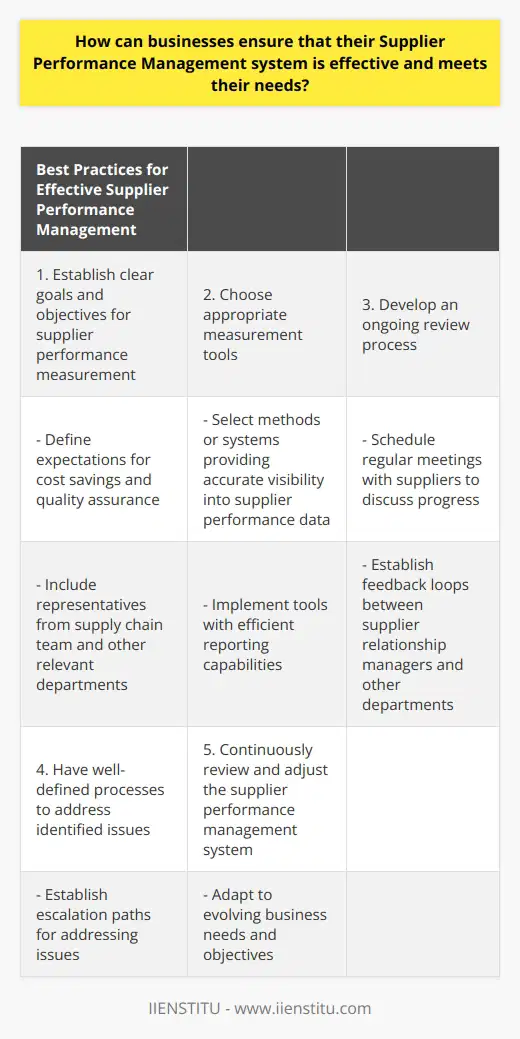
How do you enhance supplier performance through the implementation of an SRM framework?
Enhancing Supplier Performance
To enhance supplier performance, an effective Supplier Relationship Management (SRM) framework can be implemented. This framework includes various strategic approaches, processes, and tools that help in fostering productive, mutually beneficial relationships with key suppliers.
Establishing Clear Objectives
Firstly, it is essential to establish clear objectives for the SRM framework. These objectives should be aligned with the company's overall strategic goals and should aim to optimize the value generated from supplier interactions. This step helps in setting achievable targets for both the organization and its suppliers.
Developing Collaboration and Trust
The next step is to foster collaboration and trust between the organization and its suppliers. This can be achieved through transparent communication, sharing relevant information, and engaging suppliers in decision-making processes. Collaboration enables improved understanding of the supplier's capabilities and helps in identifying opportunities for joint innovation and cost reduction.
Regular Performance Reviews
Regular performance reviews are crucial to assess and enhance supplier performance. The SRM framework should allow for continuous monitoring, feedback, and adjustments based on key performance indicators (KPIs) and predefined goals. Performance reviews help in identifying gaps and opportunities, facilitating improvements in supplier performance over time.
Training and Capability Development
Investing in capability development and training of suppliers is another essential component of an SRM framework. Providing access to relevant resources, best practices, and training can improve supplier competencies, resulting in better products and services. Customized training programs can be developed, concentrating on areas of improvement and specific skill sets.
Continuous Improvement and Benchmarking
Lastly, adopting a continuous improvement approach and benchmarking supplier performance against industry best practices is important. This can help organizations in identifying and promoting suppliers that demonstrate exceptional performance. By incorporating regular review processes and maintaining open communication channels, it is possible to facilitate continuous improvement, ensuring suppliers remain competitive in the market.
In conclusion, implementing an SRM framework can significantly enhance supplier performance. By defining clear objectives, fostering collaboration, conducting regular performance reviews, investing in training, and promoting continuous improvement, organizations can build strong and sustainable relationships with their suppliers. This not only helps in achieving the organization's strategic goals but also allows both parties to create shared value and long-lasting success.
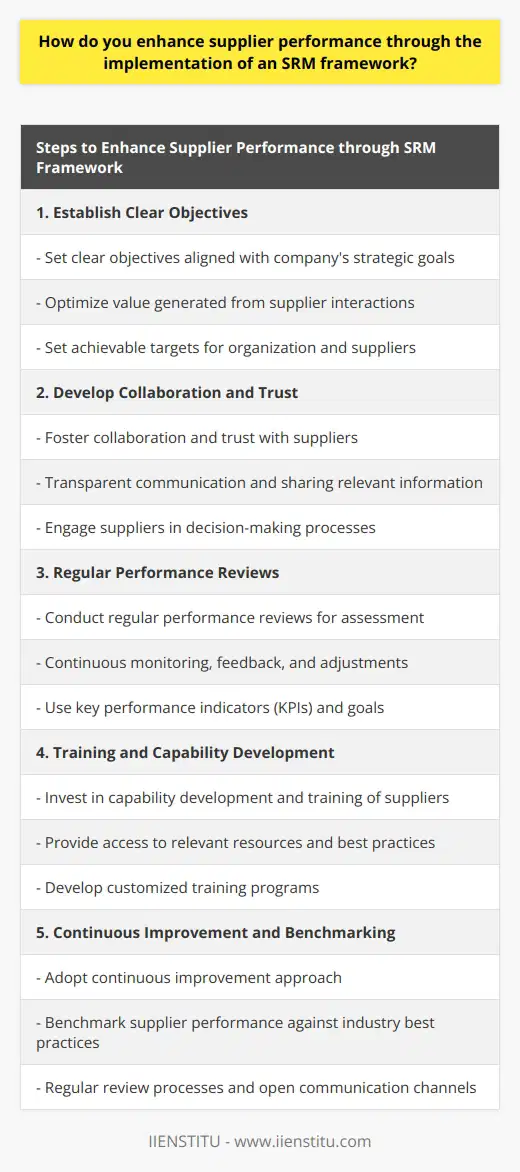
What are the most effective methods for assessing supplier performance in order to drive continuous improvement?
Key Performance Indicators (KPIs)
One of the most effective methods for assessing supplier performance to drive continuous improvement is establishing and tracking Key Performance Indicators (KPIs). KPIs are quantifiable measures used to evaluate progress, efficiency, and success in achieving predefined objectives. When appropriately designed, KPIs provide an objective basis for evaluating supplier performance and identifying areas for improvement.
Supplier Scorecards
Another effective method is utilizing supplier scorecards, which consolidate relevant data and KPIs, enabling companies to evaluate suppliers based on a predetermined set of criteria. Supplier scorecards allow for quick comparison between different suppliers and help to identify performance trends.
Regular Audits and Assessments
Conducting regular audits and assessments of supplier operations can also be highly effective in driving continuous improvement. On-site assessments provide direct insight into the supplier's processes and can identify potential bottlenecks or areas for improvement. Furthermore, regular communication between the company and the supplier can highlight possible issues before they escalate, resolving them more efficiently.
Collaborative Improvement Initiatives
Encouraging collaborative improvement initiatives between the company and suppliers can yield significant results in terms of performance enhancement. By encouraging open communication and fostering partnerships, companies can work closely with suppliers to identify issues and develop joint solutions.
Supplier Development Programs
Implementing supplier development programs, which involve investing time and resources in building suppliers' capabilities, can drive continuous improvement. These programs may include training, technical assistance, and consulting to help suppliers enhance their skills, adopt industry best practices, and improve their overall performance.
Benchmarking and Industry Comparisons
Lastly, benchmarking suppliers and comparing their performance against industry standards can help identify top performers and encourage continuous improvement. By setting challenging targets and rewarding suppliers that meet or exceed them, companies can promote a competitive culture, resulting in better delivery, quality, and overall service.
In conclusion, effective methods for assessing supplier performance to drive continuous improvement include establishing KPIs, utilizing supplier scorecards, conducting regular audits, and promoting collaborative improvement initiatives. Additionally, implementing supplier development programs and benchmarking against industry standards can significantly enhance suppliers' performance, resulting in better delivery, quality, and overall service.
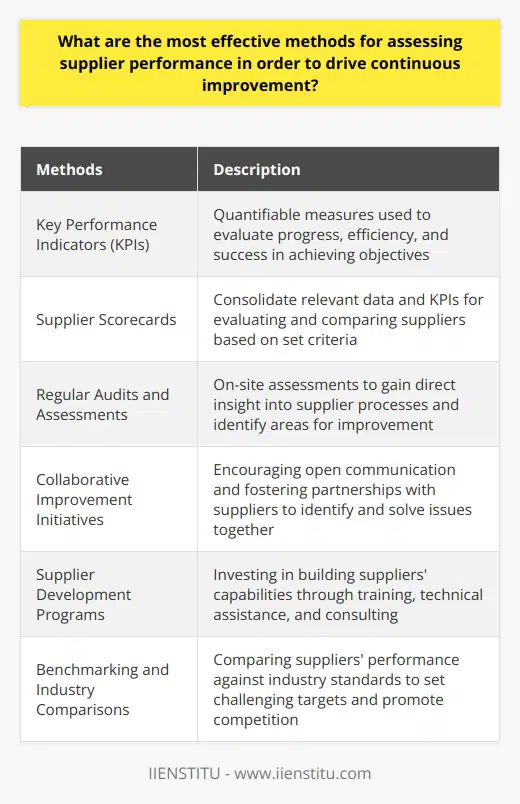
What are the four key dimensions to consider when evaluating supplier performance and their contribution to the overall business goals?
Key Dimension 1: Quality
One of the primary dimensions to consider when evaluating supplier performance is the quality of their goods or services. A supplier's ability to consistently meet or exceed the company's quality expectations directly contributes to the customers' satisfaction and loyalty, which is vital for the long-term success of a business. Monitoring product defects, return rates, and customer feedback can provide insights into the effectiveness of a supplier's quality management system.
Key Dimension 2: Cost
Another crucial aspect to consider is the supplier's cost competitiveness, which can considerably impact the business's overall financial performance. The cost competitiveness involves analyzing not only the initial price offered by a supplier but also the long-term, total cost of ownership encompassing ongoing support, maintenance, and any potential hidden costs. This evaluation helps determine whether a supplier offers a favorable balance between the supplied products' quality and the associated costs and whether they contribute positively to the company's profitability.
Key Dimension 3: Delivery
Timely and reliable delivery is a critical dimension to assess when evaluating a supplier's performance, as it affects the entire supply chain's efficiency and the business's ability to meet customer demands on time. Measuring metrics such as on-time delivery rate, lead time, and responsiveness to urgent requests can provide a comprehensive understanding of the supplier's aptitude in managing logistics and their overall contribution to the company's success in keeping the product inventory at optimal levels.
Key Dimension 4: Innovation
Lastly, a supplier's capacity for innovation and continuous improvement plays a vital role in supporting businesses' long-term growth and competitiveness in rapidly changing market conditions. Assessing a supplier's R&D capabilities, proactivity in offering new solutions, and their flexibility in adapting to new technologies and trends can offer valuable insights into the potential synergies between the supplier and the business. A supplier that drives innovative breakthroughs can contribute to the overall company's objectives by expeditiously creating new market opportunities and improving operational efficiency.

How do you align supplier performance KPIs with overall business objectives?
Assessing Supplier KPI Alignment with Business Objectives
Aligning supplier performance Key Performance Indicators (KPIs) with overall business objectives begins with identifying relevant KPIs. These should tie directly to business goals.
Setting Appropriate KPIs
First, establish KPIs that reflect performance areas critical to your business. Consider aspects such as delivery time, product quality, and responsiveness to issues. KPIs must be measurable, specific, and realistic to ensure alignment.
Prioritizing KPIs
Not all KPIs have equal significance. Balance is crucial. Prioritize KPIs according to their impact on your business objectives. High-priority KPIs should tie closely to your strategic goals.
KPIs Must Drive Action
Remember, KPIs should inform and drive action. They serve as indicators of whether a supplier's performance supports or hinders your business objectives. If KPIs indicate suboptimal performance, take prompt corrective action.
Alignment through Communication
Frequent communication ensures that suppliers understand how their performance affects your business. Regularly share KPI results and provide feedback. This helps suppliers gauge their progress and align their operations more closely with your objectives.
Regular Review of KPIs
Business goals often evolve, necessitating regular KPI review. When your objectives shift, adjust your KPIs accordingly. This keeps supplier performance aligned with current business priorities.
In conclusion, aligning supplier performance KPIs with overall business objectives is an ongoing, dynamic process. It necessitates setting appropriate KPIs, prioritizing them, driving action-based KPIs, maintaining open communication, and conducting regular performance reviews. This alignment is vital for achieving strategic business objectives and creating beneficial supplier relationships.
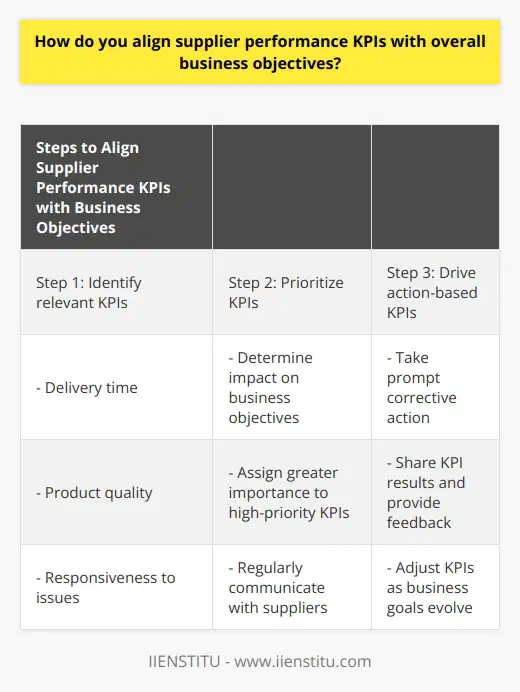
What are the best practices for setting and communicating supplier performance expectations and requirements?
Clear Definition of Expectations
The best practice begins by clearly defining performance expectations. Companies should outline performance standards, terms, and conditions in supplier contracts. These might include the quality of goods, timeliness of delivery, and compliance with regulatory requirements.
Effective Communication Strategy
Next is establishing an effective communication strategy. Open and transparent communication forms the foundation of strong supplier relationships. Companies should regularly exchange feedback with suppliers. They can leverage meetings, email updates, and business review sessions for this exchange.
Comprehensive Supplier Performance Metrics
The use of comprehensive supplier performance metrics is also vital. Companies should establish metrics that are smart, measurable, achievable, relevant, and time-bound (SMART). These metrics must align with the company's goals and should be shared with suppliers to ensure they understand the standards expected.
Performance Evaluation and Feedback
Regular performance evaluation and timely feedback to suppliers are also imperative. Regular audits and performance evaluations can identify areas of strong performance or opportunities for improvement. Companies should promptly communicate these findings to their suppliers.
Continuous Improvement and Development
Lastly, companies should aim for continuous improvement and development. They should support suppliers with necessary training and resources to meet performance expectations. Companies should consider collaborative efforts with suppliers to improve processes, reduce errors, and enhance efficiency.
In conclusion, by setting clear expectations and communicating these effectively, firms can shape supplier behavior to align with their own goals. Regular performance evaluations, continuous improvement, and development further ensure that suppliers remain committed to meeting these expectations.
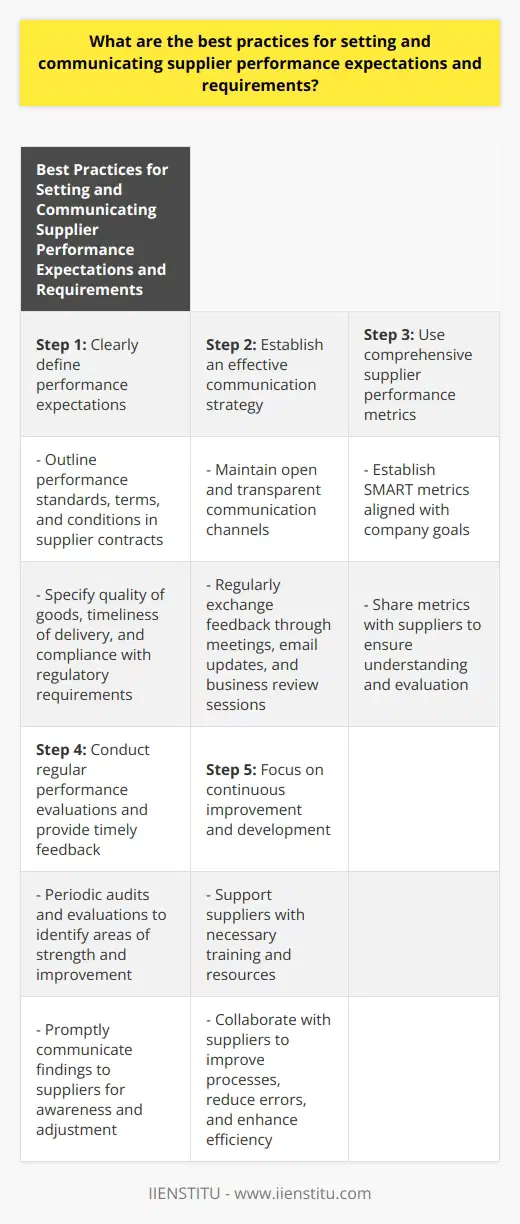
How can organizations effectively utilize supplier performance data to drive continuous improvement and innovation within their supply chain?
Applying Supplier Performance Data
Organizations can utilize supplier performance data to foster continuous improvement and innovation in their supply chain. This process involves several steps.
Data Collection and Analysis
Primarily, data collection stands as the first step. Organizations should gather detailed quantitative and qualitative information about suppliers' performance. This data may include information on delivery times, order accuracy, and quality of goods.
Next, organizations should engage in rigorous data analysis. This involves breaking down the collected data and interpreting it for valuable insights. It uncovers areas where suppliers excel or fall short.
Supplier Evaluation
Based on this analysis, they can evaluate supplier performance against set benchmarks. If a supplier's performance falls short, organizations can address these concerns. Timely communication with underperforming suppliers can facilitate improvements.
Supplier Development Programs
Organizations can also use the performance data to develop Supplier Development Programs. These programs aim to improve supplier capabilities through training and resources sharing. By boosting supplier performance, organizations enhance their supply chain operation.
Driving Innovation
Performance data also plays a key role in driving innovation. By identifying areas where suppliers struggle, organizations can implement innovative solutions to overcome obstacles. This step, in turn, fosters continuous improvement in the supply chain operation.
Performance data can also inspire innovation within the organization itself. By understanding supplier strengths and weaknesses, organizations can formulate new strategies, processes, or products to gain a competitive edge.
In summary, using supplier performance data can lead to significant enhancements in an organization's supply chain. This data-driven approach allows for efficient supplier management, fosters continuous improvement, and drives innovation. The result is improved overall performance and greater organizational competitiveness.
